Every firearm has a sound that is instantly recognizable, and gun enthusiasts often appreciate the unique auditory experience associated with shooting. Understanding what gives a firearm its signature sound requires breaking down the elements that contribute to its noise.
From the type of ammunition used to the design and materials of the firearm, there are multiple factors behind the booming or crackling sounds you hear at the range. Each shot tells a story of precision engineering and ballistic science.
The Role of Ammunition in Sound
The type of ammunition a firearm uses plays a major role in creating its sound signature. When you fire a round, the primer ignites the gunpowder, producing gases that expand rapidly and propel the bullet through the barrel. The speed of the gases and the bullet breaks the sound barrier, producing the iconic “crack” or “bang” associated with a firearm.
For example, supersonic ammunition generates a louder and sharper sound due to the shockwave created as the bullet exceeds the speed of sound. Subsonic rounds produce quieter sounds because they remain below this threshold, making them popular for use with suppressors.
Firearm Design and Materials
The design and construction of a firearm also contribute to its acoustic profile. Elements like barrel length, chamber size, and internal components influence the way a firearm generates and disperses sound waves. A shorter barrel tends to produce a louder and more abrupt noise, whereas longer barrels can reduce perceived sound levels by allowing gases to dissipate more gradually.
Additionally, the materials used in a firearm, such as steel, polymers, or lightweight alloys, can affect acoustic resonance. Understanding sheet metal gauge thickness is essential in firearm manufacturing, as it impacts durability and the way sound reverberates through the weapon.
Environmental Factors on Sound
The surrounding environment plays a significant role in shaping a firearm’s signature sound. When fired in an open field, the sound from a gunshot dissipates quickly, creating a sharp yet clean echo.
Meanwhile, indoor ranges or enclosed spaces intensify the sound due to reflected sound waves. Weather conditions, such as humidity and temperature, can also alter how sound travels through the air. Enthusiasts shooting in different environments will notice these variable effects on the auditory experience.
The Unique Symphony of Firearms
For gun owners and firearm enthusiasts, the auditory experience is as much a part of shooting as accuracy or handling. Understanding what gives a firearm its signature sound deepens the appreciation for the craft behind each weapon. The next time you fire your favorite gun, take a moment to reflect on the science and artistry behind that unmistakable sound.
Casey Cartwright
Latest posts by Casey Cartwright (see all)
- 6 Essential Accessories Every Rooftop Camper Needs – May 7, 2025
- What Gives a Firearm Its Signature Sound? – May 6, 2025
- Essential Tools for Camping and Hunting in Remote Areas – May 2, 2025

Leave a Reply